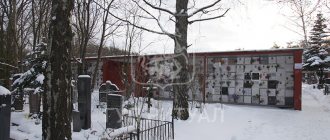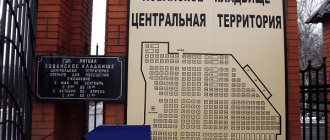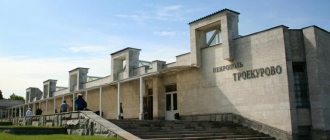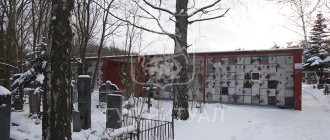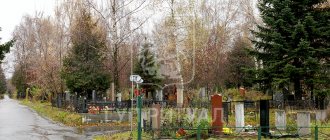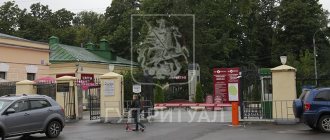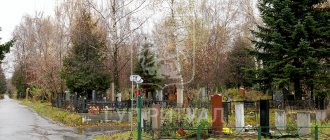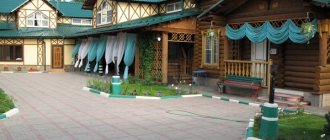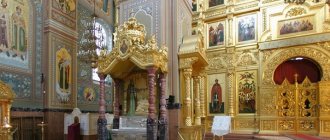Nikolo-Arkhangelskoe cemetery is one of the largest in the Moscow region. It was created in 1960 in Balashikha, and currently occupies an area of almost 150 hectares. At the Nikolo-Arkhangelskoye cemetery, in addition to places for traditional burials, places are provided for funeral urns in the columbarium, and also on its territory there is a crematorium (the crematorium of the Nikolo-Arkhangelskoye cemetery is one of the largest in the world), the Church of the Intercession of the Blessed Virgin Mary and the chapel of the Martyr Uar. Over the sixty years of its existence, the Nikolo-Arkhangelskoe cemetery has become the final refuge for many famous personalities: forty heroes of the USSR and the Russian Federation, many scientists and artists are buried here. Our material will be devoted to some of them.
Igor Akimushkin
Igor Ivanovich Akimushkin is a famous Soviet biologist and popularizer of science. After graduating from the Faculty of Biology and Soil Sciences of Moscow State University in 1952, Akimushkin worked at the Institute of Oceanology of the USSR Academy of Sciences, taught, created methodological, popular science and other literature, including writing children's works about animals. Thanks to his extensive literary and journalistic activities, in 1973 Akimushkin became a member of the USSR Writers' Union, and in total during his life he created 96 works. The books that made Akimushkin famous throughout the USSR were “Traces of Unseen Beasts” and “The Path of Legends: Tales of Unicorns and Basilisks”: in them, the scientist told amazing stories of discoveries of new biological species that were made in attempts to prove or refute rumors and myths about the legendary animals. Akimushkin’s most famous publication to this day is the six-volume book “Animal World”. Since the late 1960s, Akimushkin has also taken part (mainly as a screenwriter) in the creation of television programs and documentaries about animals. Akimushkin died at the age of 64, on April 19, 1993. Igor Ivanovich rests in the Nikolo-Arkhangelsk cemetery along with his son Igor Igorevich. Their tomb complex is a structure made of black granite. The rectangular stele, crowned with an Orthodox cross, stands on a rectangular stand, in which two flower vases are also mounted, and the corners are decorated with spherical tops. The engraving on the front side gives the names and dates of life of the deceased.
To be buried on Nikolka
This cemetery is considered closed. Only plots for related sub-burials are available. If a direct relative is buried on the territory of the cemetery or the deceased has merits for his homeland or Moscow, then there is no need to pay for a burial place.
There is a special procedure for requesting and free registration of a burial place. Relatives of a deceased citizen with merit must apply through the Department of Trade and Services. In special cases, the decision is made by the Government.
You can purchase a place in the cemetery for a family burial at auctions organized by the capital's authorities. Such services are available only to wealthy citizens.
Irina Pototskaya
Irina Aleksandrovna Pototskaya is a famous Soviet theater and film actress. After graduating from the conservatory with a degree in piano, Pototskaya entered the school at the Moscow Art Theater, but did not have time to graduate due to the liquidation of the educational institution for political reasons. Nevertheless, Pototskaya and her fellow students were accepted into Moscow theaters. As a result, Pototskaya worked for about forty years at the N.V. Gogol Theater, where her most famous works are considered to be her roles in the plays “Shelmenko the Batman” and “The Last Victim.” Pototskaya also worked on the radio, including taking part in dubbing radio plays, and collaborated with Soyuzmultfilm, voicing cartoon characters. Pototskaya lived for 93 years and died on April 7, 2009. She rested in a grave without a fence, surrounded by a granite flower bed, thanks to which for most of the year the modest stele is surrounded by greenery on almost all sides. The stele is a classic black granite rectangle with a rounded top side. On the front side of the stele there is an engraving with the name and dates of Pototskaya’s life.
Famous Graves
The Nikolo-Arkhangelskoe cemetery is a kind of museum. People often come here to see the final resting place of one of the famous Russians:
- scientists;
- artists and cultural figures;
- Heroes of the USSR and Russia.
The sailors of the legendary Kursk submarine and the military personnel who saved children in Beslan rest here. One of the last burials is the grave of singer Zhanna Friske.
But there is a special grave on the territory of the churchyard. Elder Sampson is buried there. He was the son of a count and a friend of Emperor Nicholas II. The saint endured many ordeals and completed his earthly journey as a hierodeacon in 1979. Over time, miracles of healing began to occur at the martyr’s grave. People come here for a miracle, asking for it for their children, for healing and other aspirations. People believe that their requests will be heard.
Iya Arepina
Iya Alekseevna Arepina is a Soviet and Russian theater and film actress. After graduating from VGIK in 1954, Arepina got a job at the Theater-Studio of a Film Actor and began actively acting in films. Her first works were roles in the films “Big Family”, “Ilya Muromets”, “Walking Across Three Seas”, but Arepina became famous after her role in “The Captain’s Daughter” in 1959 - this film brought the actress not only all-Union, but also worldwide fame . Iya Arepina died at the age of 73 on July 24, 2003. Arepina's tombstone is a classic rectangular stele with a rounded top made of black granite, but what is of interest is the extensive engraving that occupies almost the entire front side of the stele. In addition to the dates of life and the name of the actress, an epitaph is engraved here (lines from M. Lermontov’s poem “Mtsyri”), and also contains ceramic inserts with photographs depicting Arepina in her most famous cinematic images. In front of the tombstone there is a modest flowerbed without a fence.
Memorial – Nikolo-Arkhangelskoye Cemetery
In 1960, by decision of the Moscow City Council, one of the largest cemeteries in Moscow with an area of 138 hectares, called Nikolo-Arkhangelsk, was founded. Located in the Eastern Administrative District of the city, it is part of the State Unitary Enterprise “Ritual”. Near the central entrance of the cemetery there is the chapel of the Martyr Huar, and near the north-eastern entrance there is the Church of the Blessed Virgin Mary, built in 1990-2000. Since the founding of the cemetery, a permanent archive has been maintained to register those buried.
38 Heroes of the Soviet Union and Heroes of Russia, veterans of the Great Patriotic War, internationalist soldiers, special forces soldiers, sailors from the Kursk agro-industrial complex and many other military personnel who died in the line of duty in peacetime, famous artists - all these people are buried on Nikolo- Arkhangelsk cemetery.
Such famous personalities as Gennady Yalovich (1937-2002), actor, director, artistic director of the theater “Association of Artists MXAT”, artist Gera Sufimova - “mother” of the crow Karkushi from “Good Night, Kids”, Iya Arepina, cult actress are buried here 50-60s of the twentieth century. Having received the role of Masha, one of the main ones in the film “The Captain's Daughter” (1958), Arepina became famous. Other films with the participation of the actress are also known, such as “Big Family” (1954), “Ilya Muromets” (1956), “The Fighter and the Clown” (1957), “Under the Sound of Wheels” (1958), “Red Leaves” (1958 ), “Walking across Three Seas” (1958), “When Bridges Are Drawn” (1963), “An Incident That No One Noticed” (1967), “Kalina Krasnaya” (1973), “Don’t Forget to Look Back” (1988) and etc. The actress is buried on plot 1/15 near the grave of the famous artist Muratov Radier Zinyatovich (1928-2004), who became famous after the release of the famous comedy “Gentlemen of Fortune” (1971), where the actor played the role of Vasily Alibabaevich. But this is far from his only significant role. Such films with the participation of R. Muratov are known as “Maxim Perepelitsa” (1955), “Duel” (1957), “Time, forward!” (1965), “Shield and Sword” (1968), “Golden Calf” (1968), “Everyday Life of Criminal Investigation” (1973), “Afonya” (1975), “Eternal Call” (1983), etc.
The famous bard, Viktor Berkovsky, is also buried at the Nikolo-Arkhangelskoye cemetery. His grave is located behind the crematorium building, on plot 77a.
The Nikolo-Arkhangelskoye Cemetery provides a full range of burial services: burial with a coffin in the ground, burial of an urn with ashes in the ground, burial of an urn with ashes in niches of open and closed columbariums, production of monuments and tombstones, landscaping of burial sites. The cemetery contains a service area for family (tribal) burials and a place for burial of urns with ashes.
The territory of the cemetery is constantly being improved, landscaped, and landscaping work is underway.
Currently the following types of burials are carried out at the cemetery:
- family (ancestral) burials;
— burial by urn in a closed columbarium;
— burial with an urn in an open columbarium;
- burial with an urn in the ground.
Address: 143149, Moscow region, Balashikha district, Nosovikhinskoe highway, 16
Phone: 791-05-39
Contact person: Rukin Igor Yulianovich (Central), Tumina Vera Alekseevna (East)
Directions: from the station. Shchelkovskaya metro station, bus route No. 760 to the final stop, from Vykhino metro station bus route No. 706 to the final stop
Scheme of the Nikolo-Arkhangelsk cemetery
Source
Photo
List of famous people buried in this cemetery:
| Pashkovsky Alexander Givich |
Comments:
If you want to leave a comment, you need to log in to the site.
Ivan Aksenchuk
Ivan Semyonovich Aksenchuk is a famous Soviet animator and animator. Aksenchuk’s youth fell on the difficult years of the Great Patriotic War, in which he took part until the winter of 1945, when he was wounded. However, a few months later he was able to take part in the Victory Parade on Red Square in Moscow. In 1946 Aksenchuk began his training in the art of animation. His first works were the cartoons “Polkan and Shavka” and “Grandfather and Granddaughter” created at the Soyuzmultfilm studio, where he played the role of assistant director. Since 1953, Aksenchuk has already acted as a director - over the next few years he has been engaged in animated film adaptations of fairy tales of the peoples of the world - Romanian, Uzbek, Italian, etc. Also during his career, Aksenchuk created several so-called “poster films” that praised certain achievements of the state: these included “Our Sun”, “Glory to you, heavenly brothers!”, “Plus electrification”. In 1988, Aksenchuk retired, after which, as far as is known, he lived in poverty. On July 17, 1999, Aksenchuk died at the age of 80. The last years of his life can be judged not least by his tombstone at the Nikolo-Arkhangelsk cemetery: over Aksenchuk’s grave there is only a tiny horizontal rectangular slab with an engraving.
How to get to the cemetery
The necropolis can be reached by metro, public transport or car. Cemetery address: Nosovikhinskoe highway, 16.
If you use personal transport, travel time will depend on the starting point and traffic jams.
If you get there from the Moscow Ring Road. First you need to get to Nosovikhinskoye Highway. Then head on Ilyich Highway until the intersection with Rudneva Street. There turn right, and then left. Once on Oktyabrskaya Street, move straight to the entrance to the cemetery.
If you get from the center , it will take a longer period of time. You need to go to the embankment of the Yauza River. The next point is Nikoloyamskaya Street. Afterwards you need to cross Andronevskaya Square and Radonezhsky Street. Once on Entuziastov Boulevard, the driver moves to the interchange at the Moscow Ring Road. And then along the already planned route.
If you get there by metro , the most convenient way to do this is from Novokosino station. There you can walk to the churchyard, the path is about 2 km. Or you can use public transport: bus route E-5 (it operates when a mass visit to the necropolis is expected), transit routes 706 or 760 to the “2nd Moscow Crematorium” stop, which is the final stop.
From other stations: "Vykhino" - bus 706 or minibus 39M, "Shchelkovskaya" - bus 760 or minibus 102M.
